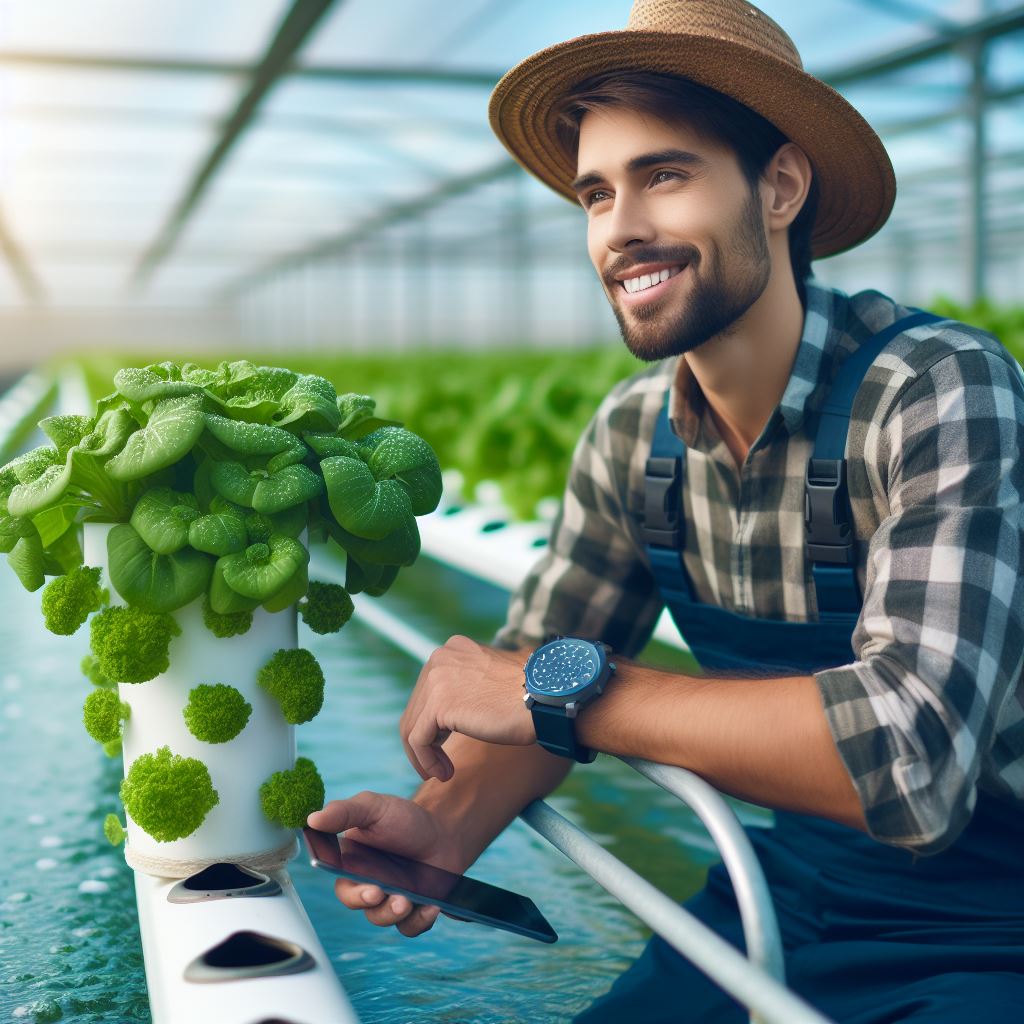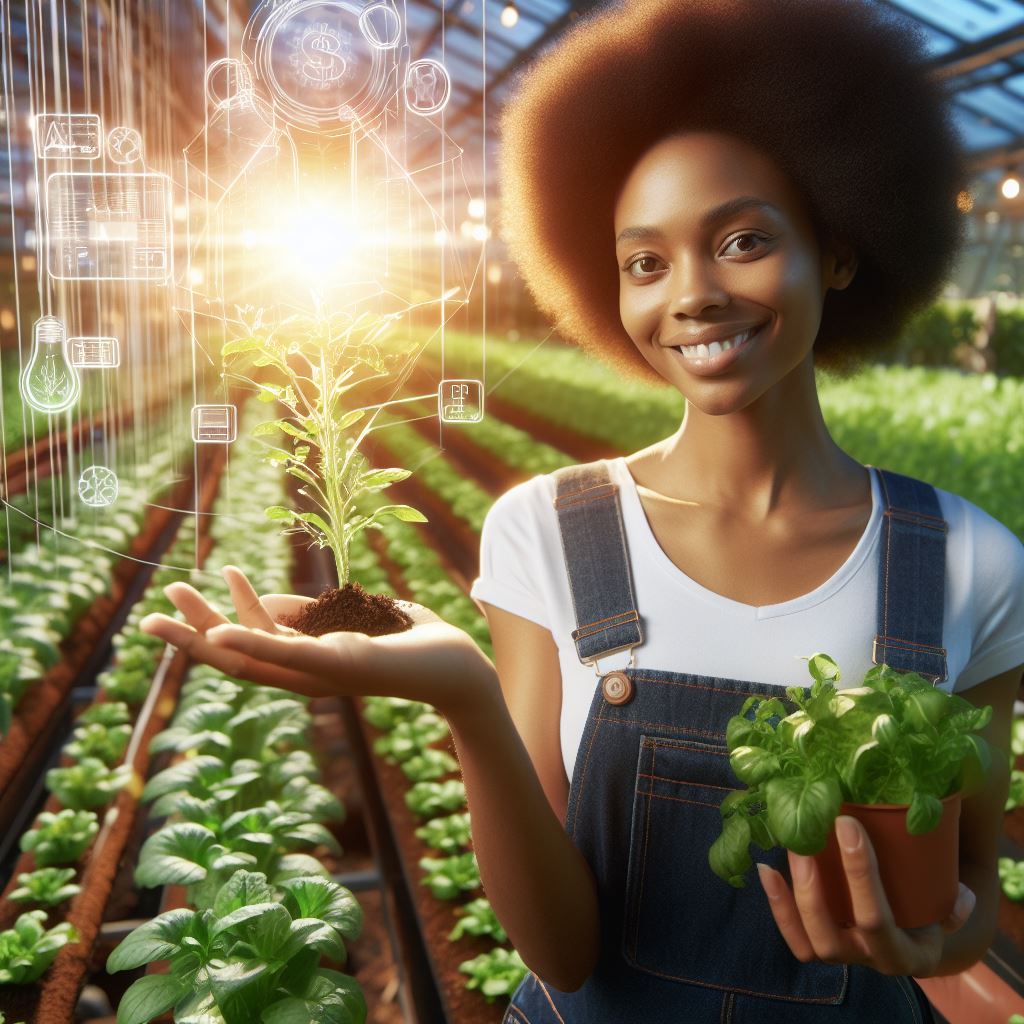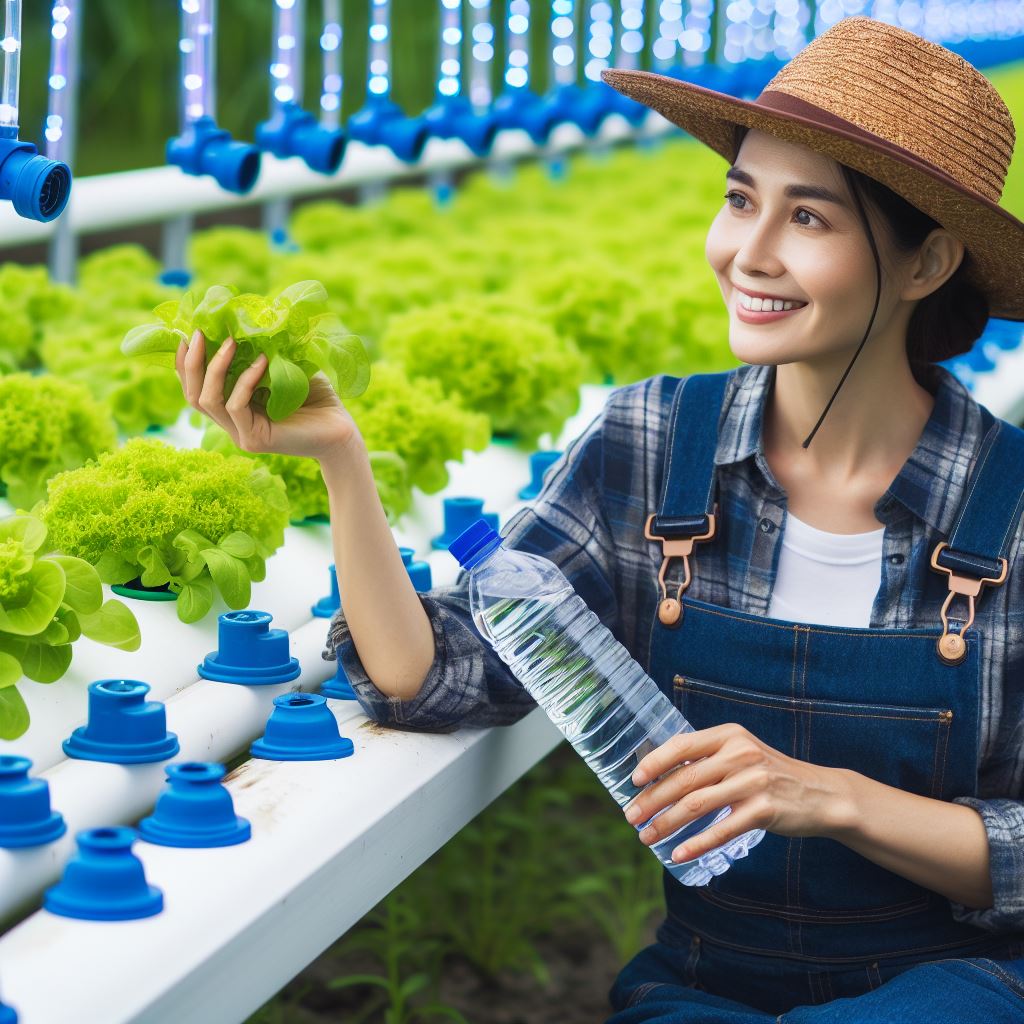Introduction
Brief introduction to Hydroponics
Hydroponics is emerging as a water-smart farming technique that does not require soil and uses up to 90% less water than traditional soil-based farming.
This soilless method of growing plants has become increasingly important as we look for innovative ways to grow more food while using less water.
In hydroponics, plants get nutrients from a nutrient-rich solution rather than soil.
The roots are supported using growing mediums like perlite, clay pebbles, coconut coir or rockwool.
The nutrient solution delivers nutrients directly to the roots, resulting in faster growth compared to soil grown plants.
Hydroponics allows farmers to grow crops using a fraction of the water needed for soil farming.
It also gives them more control over nutrient delivery and growing conditions.
Hydroponic systems can be set up anywhere – indoors or outdoors, on rooftops or balconies, ensuring year-round production.
Importance of water conservation in agriculture
With water becoming an increasingly scarce resource, hydroponics offers a sustainable way to grow food and conserve water.
Hydroponic farms use 10 times less water than conventional farms to produce the same amount of food.
This makes hydroponics ideal for water-scarce regions and an important technique for future food security.
Adopting hydroponics can significantly reduce agriculture’s burden on freshwater supplies.
Hydroponic systems recirculate and reuse nutrient solutions, enabling substantial water savings.
This water-smart farming method is critical for building resilient and productive food systems in the face of growing water stresses.
Benefits of hydroponics
In this section, we will explore the benefits of hydroponics, a water-smart farming method with numerous advantages.
Transform Your Agribusiness
Unlock your farm's potential with expert advice tailored to your needs. Get actionable steps that drive real results.
Get StartedLet’s take a closer look:
- Reduced Water Usage: Hydroponics requires only 10% of the water used in traditional soil-based agriculture. By recirculating water within the system, it minimizes wastage and conserves this precious resource.
- Year-Round Farming Capabilities: Unlike conventional farming limited by seasonal changes, hydroponics allows for year-round cultivation. By controlling environmental conditions, farmers can ensure optimal plant growth regardless of external factors.
- Increased Crop Yield: Hydroponic systems provide plants with an optimal nutrient balance, resulting in faster growth and larger yields. Studies have shown that hydroponic farms can produce up to 30% more crops compared to traditional methods.
- Elimination of Soil-Borne Diseases: Hydroponic farming eliminates the need for soil, reducing the risk of soil-borne diseases that can devastate crops. Without soil, pests and pathogens are less likely to thrive, creating a healthier growing environment.
Additional advantages of hydroponics
Apart from these key benefits, hydroponics offers several additional advantages:
- Space Efficiency: Hydroponic systems can be set up vertically or in tight spaces, making them ideal for urban environments with limited land availability. This allows for increased food production in densely populated areas.
- Resource Efficiency: As nutrients are directly delivered to the plants in hydroponics, there is no need for excess fertilizer application. This reduces nutrient runoff, preventing water pollution and decreasing the environmental impact.
- Energy Efficiency: Hydroponics operates on a closed-loop system, meaning that water and nutrients are continuously recycled. This reduces the need for irrigation and fertilization, resulting in lower energy consumption compared to traditional farming methods.
- Flexible Location: Hydroponics can be implemented virtually anywhere, including deserts, rooftops, and abandoned buildings. By utilizing unused spaces, hydroponics can revitalize urban areas and promote local food production.
- Superior Quality and Consistency: By controlling the growing conditions, hydroponics ensures consistent plant growth and high-quality produce. This can be particularly appealing to consumers who value pesticide-free and locally grown products.
Essentially, hydroponics offers numerous benefits that make it a promising solution for the future of farming.
With reduced water usage, increased crop yield, and the elimination of soil-borne diseases, this water-smart farming method presents a sustainable and efficient alternative to traditional agriculture.
By embracing hydroponics, we can address the challenges of water scarcity, food security, and environmental sustainability.
As technology and innovations continue to enhance this farming practice, hydroponics holds the potential to revolutionize the way we grow food and shape a water-smart farming future.
Read: Sustainable Farming via Tech Innovations
Methods of hydroponics
Hydroponics is an innovative method of farming that offers a water-smart future for agriculture.
With water scarcity becoming a concern, this technique has gained popularity.
Let’s explore some of the methods used in hydroponics to understand how they work.
- Nutrient Film Technique (NFT): In this method, a thin film of nutrient-rich water flows over the roots of the plants, allowing them to take up the necessary nutrients. The excess water is then collected and recirculated, minimizing waste.
- Deep-water culture (DWC): DWC involves suspending plant roots in a nutrient-rich solution. The plants’ roots are constantly submerged, receiving oxygen through air stones or diffusers, ensuring healthy growth. This technique is commonly used for growing lettuce and herbs.
- Drip Irrigation: Drip irrigation involves delivering nutrient solutions directly to the plant roots through a network of tubes and emitters. This method conserves water as it delivers water slowly, reducing moisture loss through evaporation.
- Aeroponics: Aeroponics is a technique where plant roots are suspended in the air, and nutrient-rich mist is periodically sprayed onto them for nourishment. The plants receive oxygen and water vapor, resulting in faster growth and higher yields compared to other methods.
Advantages of the hydroponic methods
These methods of hydroponics offer several advantages over traditional soil-based agriculture.
Firstly, they require significantly less water as it is reused in closed systems.
Additionally, hydroponic systems can be set up in any location, including urban areas, making it ideal for vertical farming and reducing the distance between farm and table.
Moreover, these techniques provide precise control over nutrient levels, pH, and other environmental factors, resulting in optimal plant growth.
How hydroponics removes the risks associated with soil-borne diseases and pests
By eliminating the need for soil, hydroponics removes the risks associated with soil-borne diseases and pests, reducing the reliance on chemical pesticides.
Nutrient Film Technique (NFT)
The nutrient film technique (NFT) is particularly suitable for smaller plants with shallow root systems like lettuce and strawberries.
The thin film of water is continuously re-circulated, creating an ideal balance of oxygen and nutrients for the plants.
Deep-water culture (DWC)
Deep-water culture (DWC), on the other hand, is commonly used for larger plants like tomatoes and cucumbers.
The constant submersion of the roots promotes vigorous growth and enables the plants to absorb essential nutrients effectively.
Drip irrigation
Drip irrigation, another popular method, is versatile and can be used with a wide range of crops.
By locally delivering water and nutrients to the plant roots, it ensures efficient water usage and prevents wastage.
Aeroponics
Finally, aeroponics offers a unique approach by misting the plant roots with a nutrient-rich solution.
This method maximizes oxygen absorption, allowing plants to grow faster and produce higher yields compared to traditional methods.
In general, hydroponics offers several methods to cultivate plants efficiently while minimizing water consumption.
Showcase Your Farming Business
Publish your professional farming services profile on our blog for a one-time fee of $200 and reach a dedicated audience of farmers and agribusiness owners.
Publish Your ProfileThe nutrient film technique (NFT), deep-water culture (DWC), drip irrigation, and aeroponics are all viable options that provide precise control over plant nutrition and growth.
By adopting these water-smart farming techniques, we can contribute to a sustainable future for agriculture, even in water-scarce regions.
Read: Drones in Agri: Irrigation Game Changer
Water-saving techniques in hydroponics
Hydroponics, a water-smart farming future, is gaining popularity due to its ability to grow crops without soil.
One of the major benefits of hydroponics is its water-saving techniques, which help conserve this precious resource.
In this section, we will explore some of the key techniques used in hydroponics to minimize water usage while maximizing crop production.
Recirculating Nutrient Solutions
One water-saving technique in hydroponics involves recirculating nutrient solutions.
Instead of using soil, plants are grown in nutrient-rich water solutions.
These solutions can be recirculated and reused, reducing the need for excessive water consumption.
By recirculating the nutrient solution, hydroponic farmers can significantly optimize their water usage.
Monitoring and Adjusting pH and Nutrient Levels
Proper monitoring and adjustment of pH and nutrient levels are vital in hydroponics to ensure optimal plant growth and water conservation.
By regularly testing and adjusting these levels, hydroponic farmers can prevent nutrient imbalances and minimize water waste.
Proper Water Filtration and Sterilization
Maintaining clean water is essential in hydroponics to avoid the growth of harmful bacteria and diseases.
Proper water filtration and sterilization techniques, such as using UV filters or ozonation, can help eliminate pathogens and contaminants.
By ensuring the water used in hydroponics is clean and sterilized, farmers can reduce the risk of waterborne diseases and limit water usage associated with plant health issues.
Drought-Tolerant Plant Selection
Choosing drought-tolerant plants is another water-saving technique in hydroponics.
By selecting plant varieties that naturally require less water, hydroponic farmers can further reduce their water consumption.
Some examples of drought-tolerant plants suitable for hydroponics include succulents, herbs like rosemary and thyme, and certain types of lettuce.
In essence, hydroponics offers several effective water-saving techniques that contribute to sustainable farming practices.
By recirculating nutrient solutions, monitoring pH and nutrient levels, implementing proper water filtration and sterilization, and selecting drought-tolerant plants, hydroponic farmers can minimize water usage and promote efficient crop production.
The combination of these techniques not only conserves water but also enhances the overall environmental performance of hydroponics.
As water scarcity becomes a growing concern worldwide, hydroponics presents a viable solution for sustainable agriculture, ensuring future food production while minimizing the strain on water resources.
Hydroponics is a groundbreaking approach that revolutionizes traditional farming by making it more water-smart and environmentally friendly.
By adopting these water-saving techniques, hydroponic farmers can play a crucial role in building a more sustainable and resilient future for agriculture.
Let’s embrace this innovative farming method and contribute to a water-wise world.
Read: Automated Farming: Pros & Cons Explored

Success Stories and Case Studies
Farms implementing hydroponics systems
Farms all around the world have started implementing hydroponics systems to revolutionize their farming methods and increase efficiency.
One example is Costa Farms, a nursery in Florida, which has successfully adopted hydroponics and reduced water usage by 90%.
Another success story comes from AeroFarms, an indoor vertical farming company in New Jersey, which produces over 2 million pounds of food per year using hydroponics.
Economic and Environmental Benefits Observed
The implementation of hydroponics systems has proven to bring about numerous economic and environmental benefits.
Firstly, hydroponics reduces the need for land, making it more cost-effective for farmers to produce crops in urban areas.
Hydroponics systems also use significantly less water compared to traditional farming methods, leading to water conservation and reduced water costs.
In addition, hydroponics eliminates the need for pesticides and herbicides, resulting in healthier crops that are free from harmful chemicals.
Notable Examples of Water Conservation
One notable example of water conservation through hydroponics is the Severtson’s Family Farm in Minnesota.
They implemented hydroponics systems and reduced their water usage by nearly 95% while maintaining high crop yields.
Similarly, the Green Sense Farms in Indiana has achieved remarkable water savings with the use of hydroponics technology.
By growing crops vertically without soil, they have cut down their water usage by 90% compared to traditional farming methods.
Another inspiring case is the Brooklyn Grange Rooftop Farm in New York City, which grows hydroponic vegetables on urban rooftops.
They have managed to save a significant amount of water by using closed-loop hydroponics, where water is recirculated and reused.
These success stories and case studies clearly demonstrate the effectiveness of hydroponics systems in conserving water, increasing yields, and promoting sustainable farming practices.
Showcase Your Farming Business
Publish your professional farming services profile on our blog for a one-time fee of $200 and reach a dedicated audience of farmers and agribusiness owners.
Publish Your ProfileWith the numerous economic and environmental benefits it offers, hydroponics is unquestionably a water-smart farming solution for the future.
As more farms and agricultural businesses adopt hydroponics, we can expect to see even greater advancements in water conservation and increased productivity in the agriculture industry.
Read: Climate Smart Agri: Tools & Techniques
You Might Also Like: Eco-Friendly Agri-Tech: Startups Leading the Way
Challenges and considerations in hydroponics
Hydroponics is a water-smart farming method that offers numerous benefits for sustainable agriculture.
However, it also presents some challenges and considerations that need to be addressed for successful implementation.
- Initial setup costs: Setting up a hydroponic system can be expensive due to the need for specialized equipment such as pumps, grow lights, and nutrient solutions.
- Technical knowledge requirements: Hydroponics requires a good understanding of plant biology, nutrient management, pH levels, and water circulation. Adequate knowledge is necessary for proper system functioning.
- Monitoring and maintaining proper conditions: Maintaining optimal conditions like temperature, humidity, pH levels, and nutrient balance is crucial for hydroponic success. Regular monitoring and adjustments are necessary to avoid detrimental effects on plant growth.
- Potential for system failure: Hydroponic systems are susceptible to failures, such as pump malfunctions or power outages, which can lead to plant dehydration and nutrient imbalances. Backup systems and regular maintenance are necessary to prevent these issues.
How to Overcome these Challenges
To overcome these challenges, consider the following considerations:
Start small and scale-up gradually
Begin with a small hydroponic setup to minimize initial costs and gain valuable experience.
As you become more comfortable and proficient, expand the system.
Seek guidance and education
Invest in acquiring knowledge through workshops, online courses, or consulting experts in hydroponics.
Learning from experienced individuals can help you understand technicalities and improve efficiency.
Automate and monitor using technology
Utilize technology to automate certain tasks and monitor conditions more accurately.
This can include using sensors to check pH and nutrient levels or timers to control lighting and water circulation.
Implement redundancy plans
To prevent system failures, invest in backup equipment like additional pumps and grow lights.
Consider installing redundancy systems, such as multiple nutrient reservoirs or alternate power sources like generators.
Use environmental control systems
Investing in environmental control systems can help maintain optimum conditions.
These systems regulate temperature, humidity, and CO2 levels, ensuring healthy plant growth.
Implement preventative maintenance practices
Regularly clean and inspect equipment to prevent clogs and malfunctions.
Scrutinize nutrient solutions for any signs of contamination or imbalance.
Preventative maintenance reduces the risk of system failures.
Optimize resource efficiency
Consider using renewable energy sources, such as solar panels, to power your hydroponic system.
Additionally, focus on water conservation by utilizing water-efficient techniques like recirculating systems or collecting rainwater.
In a nutshell, while hydroponics offers water-smart and efficient farming, it is crucial to address the challenges and considerations associated with it.
By considering initial setup costs, technical knowledge requirements, monitoring and maintenance, and the potential for system failure, one can successfully implement and sustain a hydroponic system.
Conclusion
Recap of the benefits and potential of hydroponics
To recap, hydroponics offers numerous benefits, including water efficiency and increased crop yields.
This method of farming has the potential to revolutionize the agricultural industry.
It allows us to grow crops in controlled environments, free from soil-borne diseases and pests.
Additionally, hydroponics requires less water and nutrients compared to traditional farming methods.
Encouragement for more widespread adoption of water-smart farming methods
In light of these advantages, it is crucial to encourage the widespread adoption of water-smart farming techniques like hydroponics.
By embracing this innovative approach, we can address the challenges posed by climate change, water scarcity, and food security.
Hydroponics allows us to cultivate crops in urban areas and arid regions, reducing our dependence on fertile land and traditional agricultural practices.
Moreover, embracing hydroponics can help establish a more sustainable and resilient food system.
By reducing water consumption and nutrient runoff, we can protect our water resources and minimize the negative environmental impact of agriculture.
Additionally, hydroponics offers farmers the opportunity to optimize space, reduce waste, and increase profitability.
With the advancements in technology and increasing awareness about the importance of sustainable agriculture, it is time to embrace the potential of hydroponics fully.
By investing in research, education, and infrastructure, we can make water-smart farming methods more accessible to farmers around the globe.
Together, we can create a future where every bite of food is cultivated sustainably, efficiently, and conscientiously.
Let us work towards a water-smart farming future for the benefit of our planet and future generations.




